Customer Self-Service Software Market Size and Share
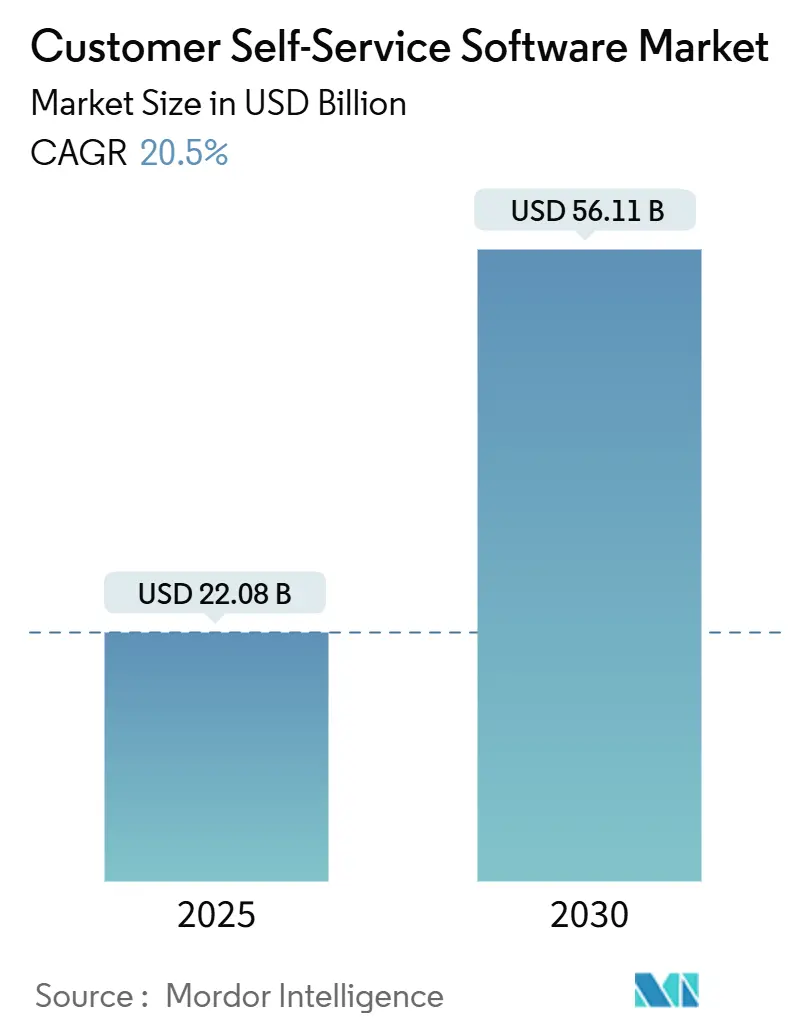
Customer Self-Service Software Market Analysis by Mordor Intelligence
The Customer Self-Service Software Market size is estimated at USD 22.08 billion in 2025, and is expected to reach USD 56.11 billion by 2030, at a CAGR of 20.5% during the forecast period (2025-2030).
The growth reflects a shift toward autonomous engagement models in which conversational AI, cloud deployment, and hyper-personalised workflows reduce wait times and trim operating costs. Vendors offering integrated platforms rather than narrow point tools earn preference, while small and mid-sized enterprises (SMEs) accelerate adoption as subscription pricing removes large capital outlays. Conversational interfaces attract sustained investment because they align with consumer expectations for natural, on-demand help. Regional funding patterns reinforce overall momentum as North American enterprises pursue optimisation projects and Asia-Pacific companies deploy first-wave systems to serve mobile-centric customers.
Key Report Takeaways
- By deployment, cloud solutions held 58.7% of the customer self-service software market share in 2024; the cloud segment is forecast to grow at a 22.1% CAGR through 2030.
- By offering, solutions captured 62.3% revenue share in 2024, while the services segment is projected to expand at a 21.6% CAGR to 2030.
- By channel, web portals accounted for 40.23% of the customer self-service software market size in 2024, whereas conversational AI is set to rise at a 24.2% CAGR through 2030.
- By enterprise size, large enterprises controlled 63.7% share of the customer self-service software market size in 2024, yet the SME segment will post the fastest 24.6% CAGR between 2025 and 2030.
- By end-user industry, banking, financial services, and insurance (BFSI) led with 24.7% customer self-service software market share in 2024; retail and e-commerce are expected to record a 21.3% CAGR.
- By geography, North America commanded 34.2% revenue in 2024, while Asia-Pacific is forecast to grow at 21.7% CAGR through 2030.
Global Customer Self-Service Software Market Trends and Insights
Drivers Impact Analysis
| Driver | (~) % Impact on CAGR Forecast | Geographic Relevance | Impact Timeline |
|---|---|---|---|
| Cloud-first CX transformation wave | +4.2% | Global, strongest in North America and Europe | Medium term (2-4 years) |
| AI-powered self-service maturity curves | +5.8% | North America led, expanding to Asia-Pacific | Long term (≥ 4 years) |
| Hyper-personalisation via customer data | +3.1% | North America and Europe; emerging in urban Asia-Pacific | Medium term (2-4 years) |
| Rising self-service adoption by Gen-Z users | +2.9% | Global, strongest in Asia-Pacific and North America | Short term (≤ 2 years) |
| Embedded self-service in vertical SaaS | +2.4% | North America and Europe; selective Asia-Pacific markets | Long term (≥ 4 years) |
| Cyber-insurance incentives for self-service | +1.6% | North America and Europe | Medium term (2-4 years) |
| Source: Mordor Intelligence | |||
Cloud-first CX Transformation Wave
Enterprises migrating to cloud-native customer experience stacks report 40–60% cost reductions and round-the-clock availability, results that encourage further investment in the customer self-service software market. [1]Splunk Inc., “Cloud Cost & Budget Trends for 2025,” splunk.com Near-instant data synchronisation across touchpoints lets agents and bots access complete history, which raises first-contact resolution rates. SMEs gain the most because subscription models avoid up-front capital requirements. Nevertheless, multi-region data residency rules complicate rollouts and reward vendors with strong migration support.
AI-powered Self-service Maturity Curves
Generative AI now interprets intent, retrieves records, and executes multi-step workflows, letting automated portals resolve up to 80% of common queries. [2]Google LLC, “Real-world Generative AI Use Cases from Industry Leaders,” cloud.google.com Companies that embed large language models inside ticketing flows register higher net-promoter scores and free staff to handle exceptions. As accuracy improves, the customer self-service software market will transition from handling routine FAQs to completing high-value, regulated transactions.
Hyper-personalisation via Customer Data Platforms
Virtual assistants that tap consolidated customer data offer device-specific suggestions and contextual answers, converting generic portals into interactive guides. Best Buy demonstrated lower ticket volumes after rolling out a data-driven chatbot. Retailers with complex catalogues benefit most, though balancing consent management with deep personalisation remains a compliance challenge across the customer self-service software market.
Rising Self-service Adoption by Gen-Z Consumers
Surveys show 78% of Gen-Z expect robust DIY options and 83% will use community forums before contacting a human. They prefer mobile chat and conversational flows that carry context across devices. Firms unable to deliver cohesive self-service risk customer churn, a reality that pushes fresh investment into the customer self-service software market.
Restraints Impact Analysis
| Restraint | (~) % Impact on CAGR Forecast | Geographic Relevance | Impact Timeline |
|---|---|---|---|
| Fragmented API security standards | -2.1% | Global; most pronounced in Europe | Short term (≤ 2 years) |
| “Quiet quit” of support agents | -1.8% | North America and Europe; emerging in Asia-Pacific | Medium term (2-4 years) |
| Data residency constraints in sovereign clouds | -1.4% | Europe and Asia-Pacific | Long term (≥ 4 years) |
| Rising CX tool sprawl cost for SMEs | -1.2% | Global | Short term (≤ 2 years) |
| Source: Mordor Intelligence | |||
Fragmented API Security Standards
Mismatched token protocols and inconsistent encryption raise integration costs, slowing deployments in the customer self-service software market. Highly regulated verticals must align CRM, ERP, and knowledge-base connections under one security model, and gaps expose new vulnerability surfaces. Vendors answering this pain point with pre-certified connectors gain traction.
Data Residency Constraints in Sovereign Clouds
Localisation mandates force multinationals to host separate data clusters, raising latency and doubling administration overhead. [3]Nutanix Inc., “2025 Enterprise Cloud Index,” nutanix.com Hybrid architectures partially solve the problem, yet they dilute the single-pane-of-glass benefits that cloud self-service promises. Providers now race to open new regional clusters and certify compliance to keep deployment pipelines active.
Segment Analysis
By Deployment: Cloud Dominance Accelerates
The cloud segment commanded 58.7% customer self-service software market share in 2024 and is forecast to maintain a 22.1% CAGR through 2030. Its rise adds scale elasticity, enabling global releases without data-centre expansion. Subscription pricing trims up-front investment and lets finance teams recognise expenses as operating outlays. Vendors continue to enrich offerings with built-in analytics that surface deflection rates and user sentiment.
Hybrid frameworks persist where sovereignty rules block SaaS in sensitive jurisdictions, while fully on-premise stacks remain concentrated in government agencies. Firms migrating from on-premises commonly adopt phased rollouts that preserve legacy ticket records yet shift new traffic to the cloud. Lower maintenance burdens and instant patching further cement the appeal, reinforcing the customer self-service software market trajectory.
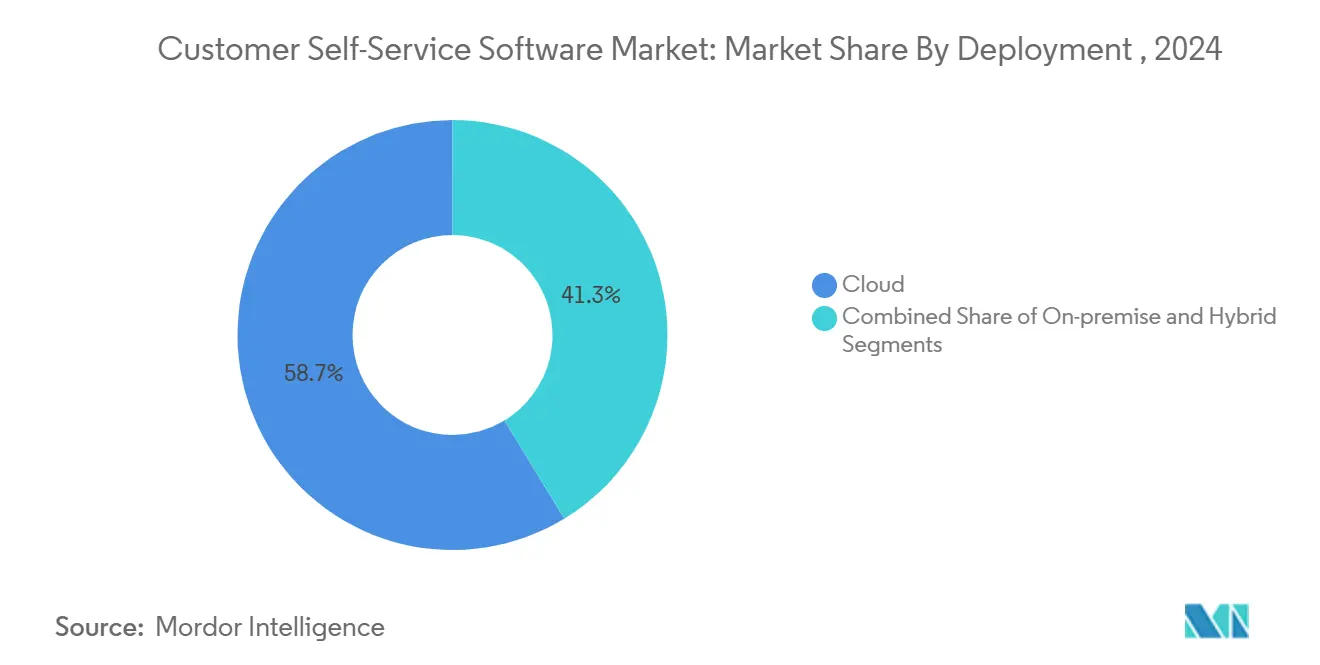
Note: Segment shares of all individual segments available upon report purchase
By Offering: Solutions Lead Platform Consolidation
End-to-end suites held 62.3% of revenue in 2024, revealing buyer desire for unified hubs that blend knowledge bases, chatbots, and analytics. The services category will grow at 21.6% CAGR as enterprises need configuration, training, and periodic optimisation. Implementation partners craft industry playbooks that map workflows and govern role-based access, guiding firms through change-management hurdles.
Vendors extend value with packaged accelerators—pre-built templates that align to ITIL processes or retail order-status flows. Continuous-improvement engagements keep modules tuned, avoiding drift between evolving business rules and bot intents. These professional-service layers deepen platform stickiness and enlarge the customer self-service software market size attached to each deployment.
By Channel: Conversational AI Disrupts Traditional Interfaces
Conversational chatbots spearhead growth at a 24.2% CAGR, overtaking static FAQs by presenting contextual answers inside natural speech flows. Web portals still process complex tasks that need rich forms, anchoring 40.23% of the customer self-service software market size in 2024. Voice and IVR handle identity verification or account unlock scenarios where spoken interaction proves fastest.
Accuracy improvements in speech-to-text and intent detection let bots tackle refund requests or subscription changes that once required an agent. Firms such as Airbnb record that one in two users prefer chat over phone, a shift signalling entrenched consumer comfort. As AI competencies deepen, channel boundaries blur because the same model can populate web widget answers, mobile app flows, and smart-speaker skills.
By Enterprise Size: SMEs Drive Adoption Velocity
Large organisations retained a 63.7% share in 2024, but SMEs will expand faster at a 24.6% CAGR as turnkey SaaS packs compress deployment windows. Simplified admin consoles, pre-trained intents, and pay-as-you-scale billing let resource-constrained companies deliver enterprise-grade journeys. The inversion of historic patterns—where big firms traditionally invested first—underscores cloud democratisation inside the customer self-service software market.
Growth also springs from marketplace ecosystems that distribute low-code plug-ins. An SME using Shopify, for example, can activate an AI assistant that syncs product catalogues and shipping status with two clicks. Community forums supply configuration recipes, cutting reliance on expensive consultants. Together, these elements pull smaller players into parity with multinationals on customer experience.
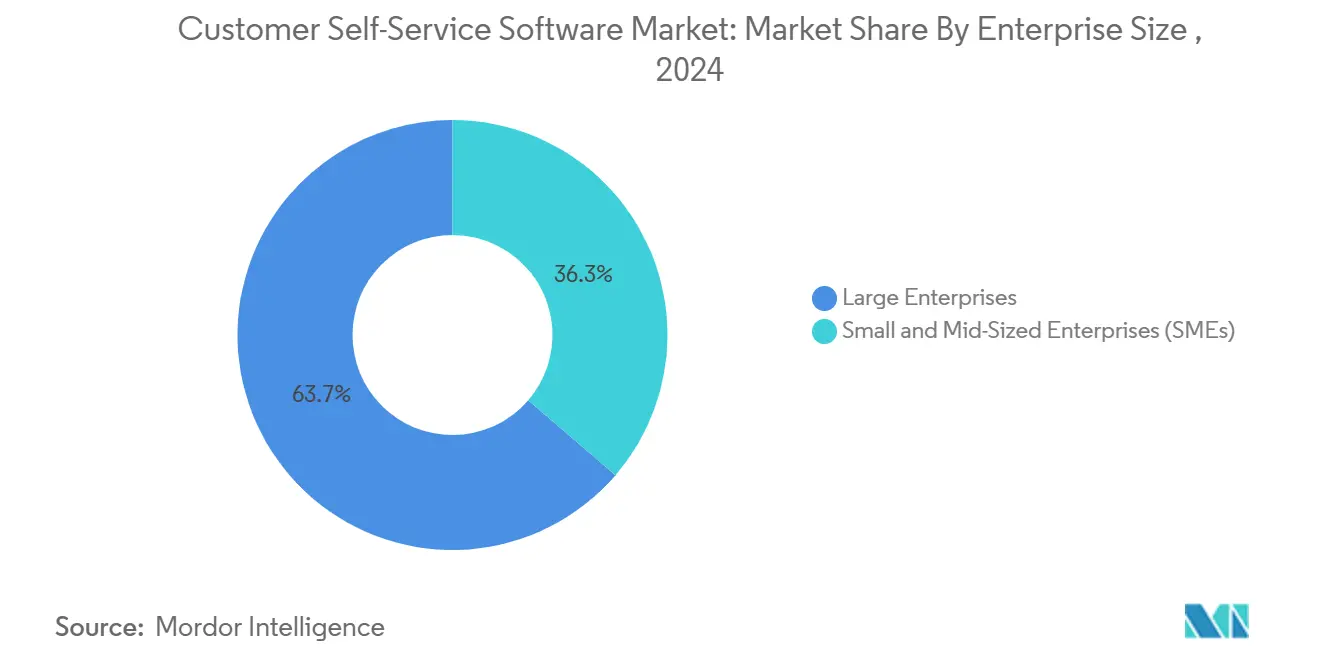
By End-User Industry: Retail Transformation Accelerates
BFSI preserved leadership with 24.7% customer self-service software market share in 2024 because regulations favour authenticated portals that log every step for audit trails. Retail and e-commerce sectors, however, will post the quickest 21.3% CAGR as rising order volumes meet demand for instant status updates and product guidance. Retailers layer bots onto inventory systems so consumers know stock levels before checkout, trimming cart abandonment. [4]Netguru, “Automation in Retail: Enhancing Efficiency and Customer Experience,” netguru.com
Healthcare organisations invest heavily in secure patient portals that automate appointment resets and billing queries. The segment shows strong parallel growth, lifted by digital-front-door initiatives aimed at relieving overloaded call centres. Education and public-sector entities adopt knowledge hubs to answer repetitive eligibility or policy questions, easing staff workloads and extending service hours.
Geography Analysis
North America generated 34.2% of 2024 revenue, supported by high cloud penetration, mature omnichannel strategies, and a tech workforce skilled in AI model tuning. Many enterprises completed first-wave deployments and now focus on fine-tuning journeys using deeper analytics. Federal-level attention to cybersecurity nudges agencies and contractors toward platforms meeting zero-trust mandates, sustaining replacement cycles.
Asia-Pacific represents the fastest expansion vector with a projected 21.7% CAGR through 2030. Its mobile-first consumer base, dominated by Gen-Z cohorts, demands chatbots that understand local dialects and karaoke-style transliteration. Governments sponsor SME digitalisation grants, indirectly enlarging demand for the customer self-service software market across retail, travel, and banking. Vendors with multilingual NLP pipelines differentiate in these environments.
Europe advances steadily despite stringent privacy statutes. The emergence of sovereign-cloud frameworks spurs regional data-centre builds, ensuring compliance. Enterprise buyers scrutinise audit capabilities and consent management before green-lighting rollouts, effectively raising the competitive bar. Although regulatory overhead tempers speed, once solutions prove compliant, adoption spreads quickly across adjacent departments, securing long-run stability.
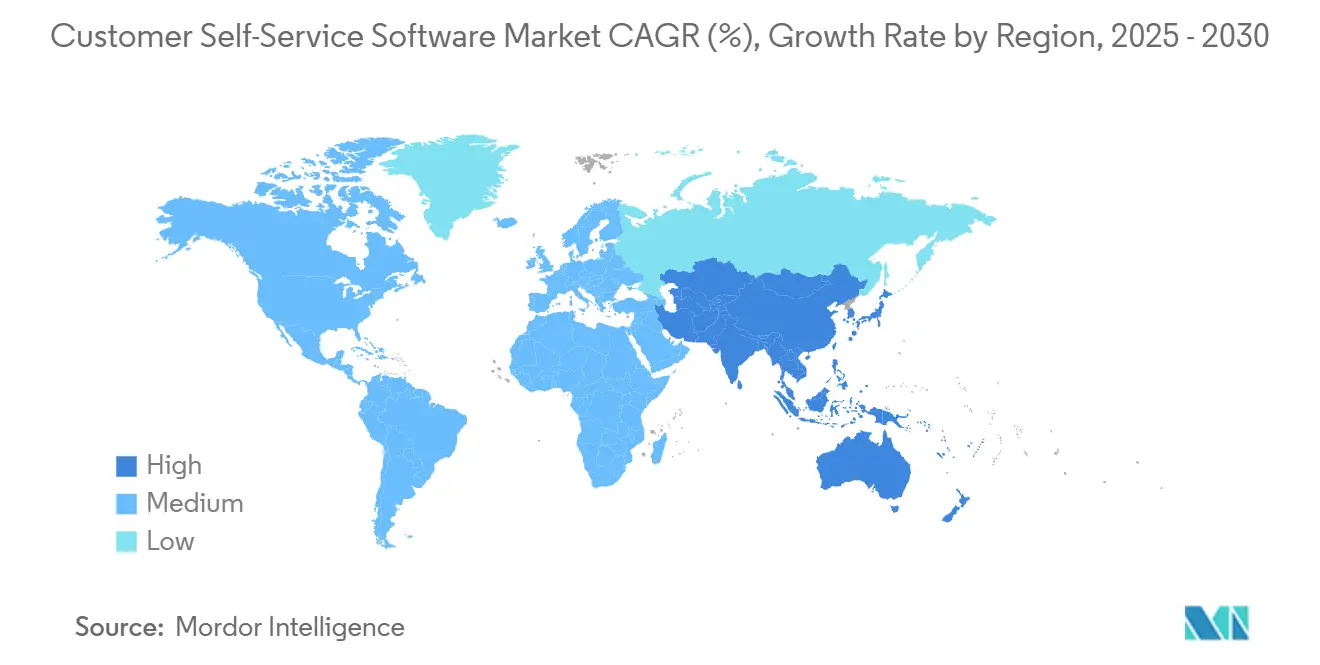
Competitive Landscape
The field shows moderate concentration as broad-suite providers such as Salesforce, ServiceNow, and Oracle bundle customer service, sales, and marketing on one data spine. Their scale affords continuous R&D investment, enabling rapid addition of generative AI copilots that troubleshoot tickets or write knowledge-base drafts. Mid-tier specialists like Zendesk and Freshworks counter with intuitive UIs and vertical presets that shorten implementation for hospitality or SaaS businesses.
Acquisition activity signals platform unification. Salesforce’s agreement for Informatica adds advanced data-pipeline tooling that enriches bot context at scale. Zendesk’s purchase of quality-assurance start-up Klaus embeds agent-performance scoring, tightening feedback loops inside its workspace. Providers able to fuse workflow, knowledge, and analytics under one licence strengthen stickiness and make rip-and-replace less attractive.
Emerging entrants build domain-specific copilots leveraging open-source LLMs. Because cloud hyperscalers now expose turnkey language APIs, barriers to entry have fallen, spurring experimentation. Nonetheless, enterprise buyers still weigh integration maturity, uptime service-level agreements, and audit trails. These requirements make consolidation likely, as smaller players either partner with or merge into established suites to reach procurement thresholds in the customer self-service software market.
Customer Self-Service Software Industry Leaders
-
Oracle Corporation
-
Salesforce Inc.
-
SAP SE
-
Microsoft Corporation
-
Zendesk Inc.
- *Disclaimer: Major Players sorted in no particular order
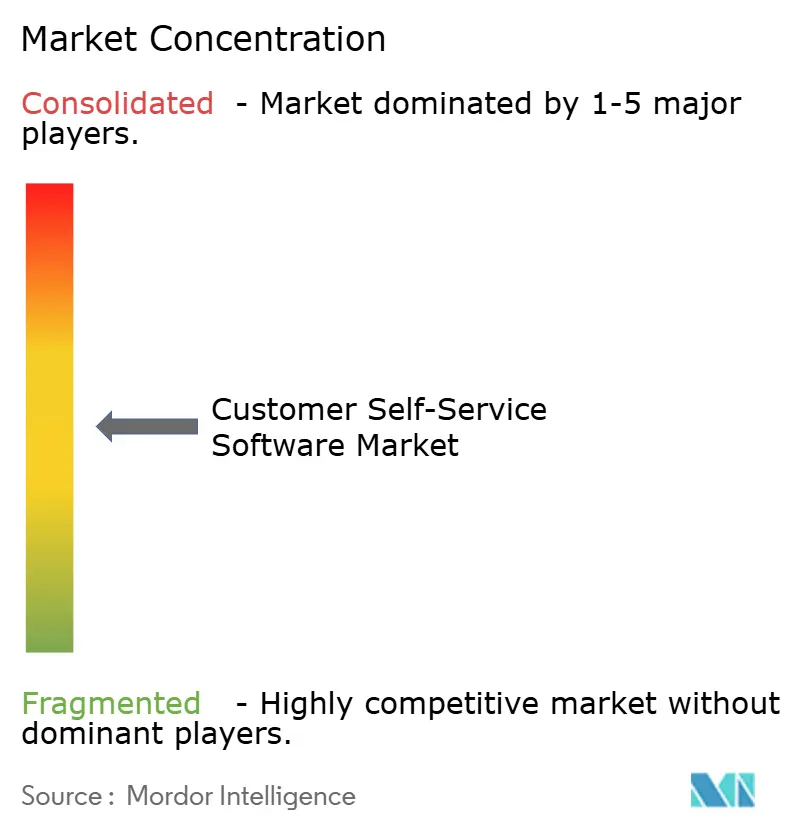
Recent Industry Developments
- June 2025: Canon launched an AI-driven support portal that reduces ticket creation by guiding users through diagnostics.
- May 2025: Salesforce completed its acquisition of Informatica to deepen data-transformation capabilities and sharpen AI-driven personalisation.
- May 2025: ServiceNow rolled out autonomous customer management modules that combine workflow automation with generative AI.
- May 2025: Verizon credited Google AI agents for measurable lifts in first-call resolution across mobile and fibre customer bases.
- April 2025: Intercom introduced “Fin,” an AI agent that autonomously handles tier-one inquiries, freeing human staff for complex tasks.
- March 2025: Google Cloud released low-latency voice AI for contact centres, supporting real-time multilingual transcription.
- March 2025: Cisco embedded predictive routing into its support suite to match customer intent with optimal resource pools.
- February 2025: Talkdesk enhanced sentiment-analysis modules that trigger proactive outreach when a negative tone surfaces.
- February 2025: Zendesk acquired Klaus, adding AI-powered quality monitoring to its workforce engagement stack.
- January 2025: ServiceNow reported USD 2.866 billion subscription revenue, up 21% YoY, attributing gains to dual seat-and-usage pricing for AI services.
Research Methodology Framework and Report Scope
Market Definitions and Key Coverage
Our study defines the customer self-service software market as the revenue generated by commercial off-the-shelf platforms, knowledge bases, conversational chatbots, web or mobile portals, IVR scripting tools, and supporting analytics, sold to enterprises so end users can resolve service needs without live-agent help. We track license, subscription, and maintenance income delivered through cloud, on-premise, and hybrid deployments across all major industries.
Scope Exclusion: Hardware such as kiosks and ATMs, contact-center telephony, generic CRM suites, and self-service business-intelligence tools are outside this report's scope.
Segmentation Overview
- By Deployment
- Cloud
- On-premise
- Hybrid
- By Offering
- Solution
- Service
- By Channel
- Web Portal
- Mobile App
- Conversational Chatbot/API
- Voice/IVR
- By Enterprise Size
- Large Enterprises
- Small and Mid-Sized Enterprises (SMEs)
- By End-user Industry
- BFSI
- Healthcare
- Retail and E-commerce
- Government
- IT and Telecommunication
- Education
- Other End-user Industries
- By Geography
- North America
- United States
- Canada
- Mexico
- South America
- Brazil
- Argentina
- Chile
- Rest of South America
- Europe
- Germany
- United Kingdom
- France
- Italy
- Spain
- Russia
- Rest of Europe
- Asia-Pacific
- China
- India
- Japan
- South Korea
- Singapore
- Malaysia
- Australia
- Rest of Asia-Pacific
- Middle East and Africa
- Middle East
- United Arab Emirates
- Saudi Arabia
- Turkey
- Rest of Middle East
- Africa
- South Africa
- Nigeria
- Egypt
- Rest of Africa
- Middle East
- North America
Detailed Research Methodology and Data Validation
Primary Research
Mordor analysts interviewed CX software product managers, system integrators, and service-desk leaders in North America, Europe, and high-growth Asian economies. These conversations validated average seat counts, chatbot-resolution ratios, and regional pricing bands, while filling gaps flagged during secondary collection.
Desk Research
We start by mapping digital service penetration using open datasets from bodies such as the US Census Bureau's e-commerce indicators, Eurostat Digital Economy statistics, ITU household internet-access surveys, and UNCTAD B2C commerce indexes. Call-center volume trends from HDI and ICMI, patent filings via Questel, and vendor financials through D&B Hoovers and Dow Jones Factiva ground our understanding of addressable demand and price points. Company filings, investor decks, and reputable trade-press interviews then refine renewal cycles and average contract values. The sources named are illustrative; many additional public records and trade databases shaped our desk analysis.
Market-Sizing & Forecasting
A top-down build begins with enterprise counts and digital support incidence rates, which are then multiplied by verified seats and average subscription pricing. Supplier roll-ups and sampled ASP × volume checks offer bottom-up corroboration before totals are adjusted. Key variables include cloud-migration share, chatbot-success percentage, digital ticket growth, average cost-per-contact, regulatory data-retention mandates, and SME SaaS adoption rates. Forecasts to 2030 use multivariate regression linking these drivers to GDP per capita, broadband penetration, and labor-cost trends. Where bottom-up inputs are thin, regional analogs and expert feedback guide calibrated assumptions.
Data Validation & Update Cycle
Outputs pass anomaly checks, variance tests against historic ratios, and multi-analyst reviews. Reports refresh annually, with interim updates for material events, and every edition receives a final pre-publication sanity pass so clients see the newest view.
Why Mordor's Customer Self Service Software Baseline Commands Reliability
Published estimates often diverge because firms choose distinct channel scopes, mix subscription and perpetual revenues differently, or refresh models irregularly. By anchoring on verified adoption metrics and an annual update cadence, Mordor delivers a balanced midpoint decision-makers can trust.
Benchmark comparison
| Market Size | Anonymized source | Primary gap driver |
|---|---|---|
| USD 22.08 B (2025) | Mordor Intelligence | |
| USD 18.07 B (2024) | Global Consultancy A | Excludes service revenue and mobile-app channels |
| USD 12.96 B (2025) | Industry Association B | Relies on narrow SME sample; omits Asia-Pacific data |
| USD 21.60 B (2025) | Trade Journal C | Blends broader customer-service software, assumes flat ASP growth |
These contrasts show that, by selecting the right scope and validating every assumption through fresh field interviews, Mordor Intelligence provides the most dependable, transparent baseline for the customer self-service software space.
Key Questions Answered in the Report
What is the current size of the customer self-service software market?
The customer self-service software market size stands at USD 22.08 billion in 2025 and is projected to reach USD 56.11 billion by 2030.
Which deployment model is gaining the most traction?
Cloud platforms lead with 58.7% market share and are forecast to grow at a 22.1% CAGR because they reduce up-front costs and enable global scalability.
Why are SMEs adopting customer self-service software rapidly?
Subscription pricing, low-code bots, and pre-configured templates remove technical barriers, helping SMEs grow adoption at a 24.6% CAGR through 2030.
Which region will witness the fastest future growth?
Asia-Pacific is expected to register a 21.7% CAGR as mobile-first consumers and government digitalisation incentives accelerate deployments.
How does conversational AI affect customer engagement?
Conversational interfaces improve resolution speed and user satisfaction, driving a 24.2% CAGR for chatbot channels that now manage complex inquiries autonomously.
What restrains wider adoption in regulated sectors?
Fragmented API security standards and strict data-residency rules raise integration costs, temporarily dampening growth until unified compliance frameworks mature.
Page last updated on:



